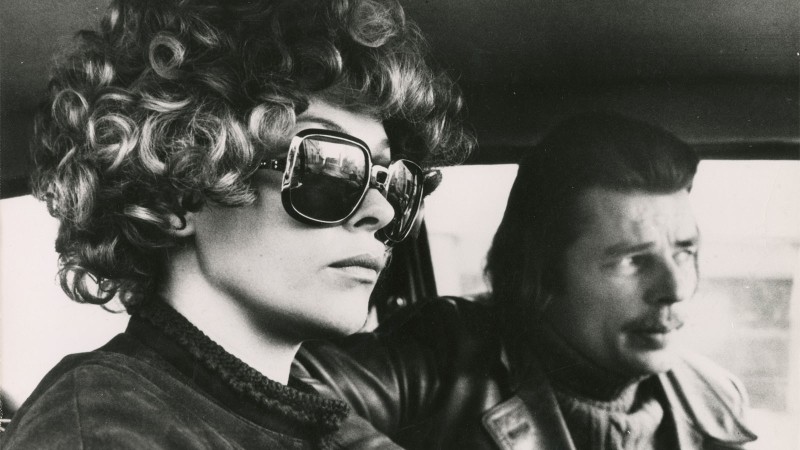Plate o’ Shrimp

Libertarian economist Javier Milei, a Trump fan and one of Elon Musk’s tightest buds, has been slashing away at Argentina’s cultural institutions—including the Institute of Cinema and Audiovisual Arts (INCAA)—since he took office as president last December. On September 24, San Sebastián (September 20 through 28) will host a special delegation of Argentine producers, filmmakers, and journalists for a full day dedicated to demonstrating the festival’s solidarity with a vital cinema in crisis.
- Our release this week of a new 4K edition of Repo Man (1984) has prompted Jonathan Marlow to call up writer and director Alex Cox, and their conversation at Hammer to Nail is an immersive tour of punk-era Los Angeles. Among the sights and sounds along the way are Kareem Abdul-Jabbar standing in line to see Kiss Me Deadly (1955), the Circle Jerks as a lounge band, thieving students at the Actors Studio, and John Wayne in a dress. Cox and Marlow also discuss the influence of the 1967 British series The Prisoner on much of Cox’s work and the project he’s working on now, Nicolai Gogol’s Dead Souls as a western shot in Spain and Arizona.
- Bahram Beyzaie’s The Stranger and the Fog (1974) is “almost unforgiving in its succession of gorgeously photographed imagery,” writes Sarah Fensom at Reverse Shot. A new restoration is heading to Berkeley and Durham and further cities and dates will be added soon. “Before he began making films, Beyzaie was a playwright, stage director, and theater historian of illustrious reputation,” notes Fensom. “Unlike several of the filmmaker’s peers in the Iranian New Wave, like Sohrab Shahid-Saless and Abbas Kiarostami, who pulled from the Italian neorealist tradition and the work of Michelangelo Antonioni and Ermanno Olmi, Beyzaie takes his cues from some of world cinema’s more robust and sensuous stylists, such as Federico Fellini, Sergei Parajanov, and, most significantly, another Shakespearean acolyte, Akira Kurosawa . . . Much of the blocking and composition of The Stranger and the Fog brings to mind the bucolic beauty of Parajanov, with each new shot presenting the viewer an image akin to a delicately structured stanza.”
- 4Columns is back from the summer break, and the new issue features film editor Melissa Anderson on the Anthology Film Archives series Essential / Unessential Warhol. From today through Sunday, Greg Pierce, the director of film and video at the Andy Warhol Museum, will present “an assortment of extremely rare Warhol titles (shorts, features, and mid-length works), all restored and digitized by the Pittsburgh institution,” writes Anderson. “Each of these bone-deep cuts—culled from a vast oeuvre in which even the most well-known films, like My Hustler (1965) or The Chelsea Girls (1966), still qualify as exotica for many cinephiles—showcases the unpredictability of a wide variety of charismatic freaks: drug- or booze-fueled motormouths, vamps of all genders, Teutonic beauties prone to gnomic pronouncements.”
- As a courtroom drama, Cédric Kahn’s The Goldman Case is “not a Hollywood-style heart-pumping work,” writes Alissa Wilkinson in the New York Times. “But it’s plenty thrilling.” It’s set almost entirely during the 1976 trial of intellectual outlaw Pierre Goldman (Arieh Worthalter), who claimed to have nothing to do with the killing of two pharmacists during the robbery he readily admitted to taking part in. In a terrific piece for Film Comment, J. Hoberman explains how Goldman became “a left-wing cause célèbre” and why The Goldman Case is “a profoundly Jewish film, unusually explicit in dramatizing the internal divisions that existed and continue to exist among Jews. It concerns not only the question of Goldman’s guilt or the possibility of his receiving a fair trial, but also the tension” between Goldman and his lawyer, Georges Kiejman, “intelligent men who understood each other too well.”
- Kiejman was something of a celebrity himself, having represented Guy Debord, François Truffaut, and Jeanne Moreau as well as publications such as Charlie Hebdo and Cahiers du cinéma. He’s played in Kahn’s film by Arthur Harari, the director and occasional actor best-known stateside for cowriting another French courtroom drama, Anatomy of a Fall, with his partner, Justine Triet. For the Guardian, Jonathan Romney talks with Harari about his family—like Goldman, his parents belonged to the Revolutionary Communist League—working with his older brother, Tom, a cinematographer, on his first feature, Dark Inclusion (2016), and with his younger brother, Lucas, a graphic novelist, on his third and next feature, The Unknown, starring Léa Seydoux. Romney naturally also asks about Harari and Triet’s new status as the “véritable power couple” of French cinema.



